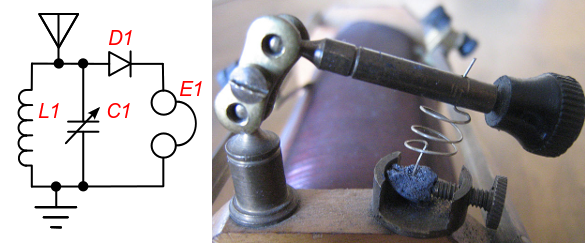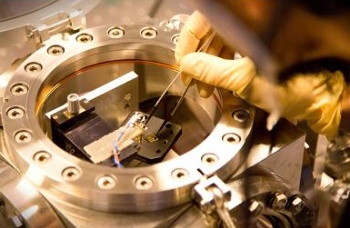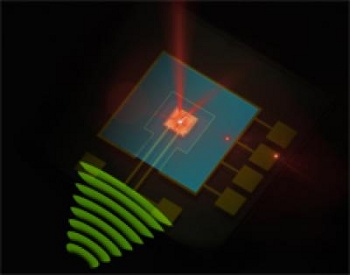Radio Detectors
March 28, 2014
German physicist,
Heinrich Hertz (1857-1894), demonstrated the
transmission and
reception of
radio waves in 1887. In his
experiments, he used a
spark gap as a generator of radio waves, and he detected the
electromagnetic radiation when it induced
sparks in another gap connected to an
antenna. When Hertz turned the spark
voltage supply on and off, it was a primitive form of
modulation called on-off keying.
In the
twentieth century, when the generation and reception of radio waves became more manageable, other modulation types were invented. With today's
digital communication technology, there are too many modulation schemes to list in an article like this. Possibly the most important type to most people is
quadrature amplitude modulation (QAM), used in
wireless local area networks.
The
US Federal Communications Commission once listed the basic modulation types shown in the table, where "A" signifies
amplitude modulation, and "F" signifies
frequency modulation. This was the list I needed to memorize when I took the
exam for my
commercial radiotelephone operator license in the
1960s.
| Type | Description |
| A0 | Unmodulated |
| A1 | On-Off Telegraphy |
| A2 | Amplitude Modulated Telegraphy |
| A3 | Telephony ("AM Radio") |
| A4 | Facsimile |
| A5 | Television |
| F0 | Unmodulated |
| F1 | Frequency Shift Telegraphy |
| F2 | Frequency Modulated Telegraphy |
| F3 | Telephony ("FM Radio") |
| F4 | Facsimile |
| F5 | Television |
Before
Edwin Armstrong invented
frequency modulation in 1933, all modulated radio was amplitude modulated. Simple devices, such as the
Branly coherer, were used as early detectors of radiotelegraphy (A1 in the above table), but they weren't capable of detecting speech signals (radiotelephony). For that, you needed a
rectifier, and the first such rectifiers were the simple "
cat's whisker"
semiconductor diodes shown in the figure.
After a while,
vacuum tube rectifiers became the radio detectors of choice, since they didn't need as much attention as a cat's whisker diode. Today, there's a wide variety of
semiconductor diode types available, priced as low as a few cents per piece.

A crystal radio circuit (left) and a "cat's whisker" detector diode (right). Early hobbyist crystal radios were more likely to have a variable inductor than a variable capacitor. The inductor was usually copper wire wrapped on a round oatmeal container with a slider to connect to different turns. The diode detector D1 was generally a cat's whisker diode formed from a galena (lead sulfide) crystal making contact to a metal wire. This type of diode is known as a Schottky diode. (Left and right images via Wikimedia Commons.)
The diode detector is sufficient for most applications, but other radio detection tasks, such as those in
radio astronomy and
medical imaging (
MRI), require better
sensitivity.
Scientists at the
Niels Bohr Institute of the
University of Copenhagen (Copenhagen, Denmark) have teamed with
colleagues at the
Technical University of Denmark (Kongens Lyngby, Denmark) and the
Joint Quantum Institute, a joint operation of the
National Institute of Standards and Technology and the
University of Maryland (College Park, Maryland) to create an
optomechanical radio detector.[2-5]
The detector is based on the fact that
nanomechanical oscillators will couple strongly to
microwave and
optical fields.[2] The device is essentially an
upconverter that translates radio frequencies to light frequencies, so a
megahertz radio signal is converted to hundreds of
terahertz.[5] This allows signal detection using
quantum optical techniques used in quantum-limited signal detection.[2]
The usual way to reduce
noise in a detector is to eliminate
thermal noise by cooling to
liquid helium temperatures. Such temperatures, although very low, still allow some thermal noise. Says
Eugene Polzik, head of the
Quantum Optics Research Center at the Niels Bohr Institute,
"We have developed a detector that does not need to be cooled down, but which can operate at room temperature and yet hardly has any thermal noise. The only noise that fundamentally remains is so-called quantum noise, which is the minimal fluctuations of the laser light itself."[4]
The device has an antenna that couples radio signals to an
aluminum-coated 50
nanometer thickness membrane formed from
silicon nitride. The membrane is one plate of a capacitor. Although the device is isolated in a
vacuum chamber (see figure), it's not cooled. The thermal noise is reduced by the thinness of the membrane. A
bias voltage of less than ten
volts is enough to induce strong coupling between the radio-frequency voltage and the membrane's displacement.[2]

Nanomechanical resonator for radio detection being placed in a vacuum chamber. Vacuum operation isolates the membrane, thereby allowing high-Q resonance.
(Photograph: Ola Jakup Joensen, Niels Bohr Institute.)
Optical coupling is made by
reflecting a
laser from the membrane surface.[2] The radio and light waves interact
non-linearly with the mechanical resonance of the membrane.[2,4] The radio signals can then be detected as an optical
phase shift with quantum-limited sensitivity.[2] The
noise equivalent temperature is just 40
mK, and the detector sensitivity limit is 5
pV per
square-root hertz.[2]
As Polzik summarizes,
"This membrane is an extremely good oscillator and that is why it is so ultrasensitive. At room temperature, it works as effectively as if it was cooled down to minus 271°C, and we are working to get it even closer to minus 273 degrees C, which is the absolute minimum. In addition, it is a huge advantage to use optical detection, as instead of using ordinary copper wires to transmit the signal, you can use fiber optic cables, where there is no energy loss."[4]

Artist's impression of the radio-light mixing at the membrane detector.
(Artist's impression by Mette Høst.)
![]()
References:
- Edwin H. Armstrong, "Radio signaling system," US Patent No. 1,941,066, December 26, 1933.
- T. Bagci, A. Simonsen, S. Schmid, L. G. Villanueva, E. Zeuthen, J. Appel, J. M. Taylor, A. Sørensen, K. Usami, A. Schliesser and E. S. Polzik, "Optical detection of radio waves through a nanomechanical transducer," Nature, vol. 507, no. 7490 (March 6, 2014), pp. 81-85.
- Mika A. Sillanpää and Pertti J. Hakonen, "Optomechanics: Hardware for a quantum network," Nature, vol. 507, no. 7490 (March 6, 2014), pp. 45-46.
- Ultra sensitive detection of radio waves with lasers, Niels Bohr Institute Press Release, March 5, 2014.
- Up-Converted Radio - The way to treat radio waves in a noisy environment is to turn them into visible light, Joint Quatum Institute Press Release, March 6, 2014
Permanent Link to this article
Linked Keywords: Germany; German; physicist; Heinrich Hertz (1857-1894); transmitter; transmission; receiver; reception; radio wave; experiment; spark-gap transmitter; spark gap; electromagnetic radiation; electric spark; antenna; voltage supply; modulation; 20th century; twentieth century; data transmission; digital communication; quadrature amplitude modulation; wireless local area network; LAN; Federal Communications Commission; amplitude modulation; frequency modulation; assessment; exam; general radiotelephone operator license; commercial radiotelephone operator license; 1960s; facsimile; television; frequency-shift keying; frequency shift telegraphy; Edwin Armstrong; frequency modulation; Branly coherer; rectifier; cat's whisker detector; semiconductor diode; vacuum tube diode; vacuum tube rectifier; crystal radio; electrical circuit; hobby; hobbyist; inductor; capacitor; copper wire; oatmeal; galena; lead sulfide; Schottky diode; Wikimedia Commons; radio astronomy; medical imaging; magnetic resonance imaging; MRI; sensitivity; scientist; Niels Bohr Institute; University of Copenhagen (Copenhagen, Denmark); colleague; Technical University of Denmark (Kongens Lyngby, Denmark); Joint Quantum Institute; National Institute of Standards and Technology; University of Maryland (College Park, Maryland); optomechanics; optomechanical; oscillation; nanomechanical oscillator; microwave; optics; optical; electromagnetic field; heterodyne; upconverter; megahertz; terahertz; quantum optics; quantum optical; noise; Johnson-Nyquist noise; thermal noise; liquid helium; Eugene Polzik; Quantum Optics Research Center; aluminum; nanometer; silicon nitride; vacuum chamber; bias voltage; volt; resonator; Q factor; high-Q; Ola Jakup Joensen, Niels Bohr Institute; reflection; reflecting; laser; linearity; non-linearly; phase shift; >noise equivalent temperature; mK; pV; square-root; hertz; room temperature; Celsius; optical fiber; fiber optic cable; energy; Edwin H. Armstrong, "Radio signaling system," US Patent No. 1,941,066, December 26, 1933.